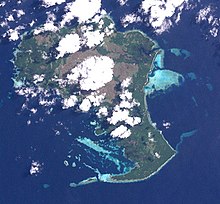

Sanaroa Island is an island, part of D'Entrecasteaux Islands in Papua New Guinea, located east of Fergusson Island in Milne Bay Province, at 9°37′00″S 151°00′00″E / 9.6166667°S 151°E. The population of Sanaroa is less than 2000.
Education
[edit]Sanaroa has one primary school run by the Catholic Church. Students come from all over Sanaroa, some walking or canoeing 5 km (3.1 mi) to school. Many of the students have rarely or never left the island, and have little exposure to urban life. The island's two main religions are the United Church and Catholic Church. In 2007 a Christian Mission Fellowship church was established. Today many students have formally done grade 8 and many have continued to High School. However the biggest problem that the students face is school fees and unfortunately many have withdrawn from school. Despite the problems a few others have been assisted and supported by their parents and relatives have ventured to find jobs in towns and are working. Education is recently seen as important to raise the standard of living and bring changes to the villages and families. Another elementary school has been built in Siawawa section to cater to children due to distance. The person behind the planning and building of the school is Mr Papu Martine from Kogeta Village.
Council areas
[edit]Sanaroa's three council areas are Etana, Siawawa Udaudana and Tewala island. The island has four council areas maily sourrended by sea.
Language
[edit]Sanaroa is a language that has faded or disappeared. The local people call it the K language because the 'k' sound is used frequently. Today there are no persons speaking the language.The last woman who used the "K" language was Mis Abokagu from Gadigadili Village.
Life style
[edit]The local people live a subsistence-farming life style. The people on the island go fishing and do gardening to feed themselves. The staple foods are yams, sago, fish and bananas. They use canoes, dinghies and other sea-going vessels as transport. There are no trucks, cars, mains power or airports on the island. The economy of the island heavily depend on the sea or the marine resource to earn cash from outside communities
Natural events
[edit]Sanaroa island is experiencing sea erosion due to wave action,and tides and sea currents and some smaller islands appear to be sinking quickly.
Well, that’s interesting to know that Psilotum nudum are known as whisk ferns. Psilotum nudum is the commoner species of the two. While the P. flaccidum is a rare species and is found in the tropical islands. Both the species are usually epiphytic in habit and grow upon tree ferns. These species may also be terrestrial and grow in humus or in the crevices of the rocks.
View the detailed Guide of Psilotum nudum: Detailed Study Of Psilotum Nudum (Whisk Fern), Classification, Anatomy, Reproduction